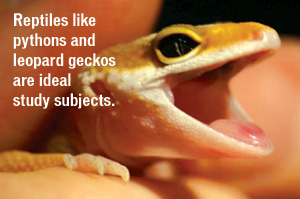Summer, 2011
A research program providing fundamental insights into craniofacial development and evolution got a bit brighter with funding from the Natural Sciences and Engineering Research Council of Canada (NSERC).
 Dr. Joy Richman, a pediatric dentist and development biologist, was awarded an NSERC Discovery Grant of over $312,000 over five years to continue her studies of reptilian tooth and jaw development.
Dr. Joy Richman, a pediatric dentist and development biologist, was awarded an NSERC Discovery Grant of over $312,000 over five years to continue her studies of reptilian tooth and jaw development.
Building on her previous molecular studies of snake genes to increase the understanding of how human jaws and teeth evolve, the first aim of the awarded research program is to elucidate the mechanisms of tooth development in polyphyodont animals (animals with successive sets of teeth).
The second aim is to understand the mechanisms for the variation in skeletal morphology in reptiles.
“In the next five years, we will be focusing on the growth-factor signalling that regulates tooth replacement and the participation of epithelial stem cells in this process,” she says. “In the skeletogenesis arm of the grant, we will focus on palate and temporal bone development.”
Her other area of expertise, using chicken embryos to shed light on facial abnormalities, is also involved: “Our approaches will be to apply the molecular and functional techniques we use in our chicken work [see Impressions, fall 2010] to the study of reptiles.”
Reptiles like pythons and leopard geckos are ideal study subjects, because as egg-laying animals, tooth development can be easily studied in the embryos. The bigger picture of Richman’s investigations using the reptilian animal model is to ascertain how the second generation of teeth (permanent teeth) forms in humans. This work will lead to a better understanding of how human tooth number is controlled and could translate into new methods of regenerating lost teeth.